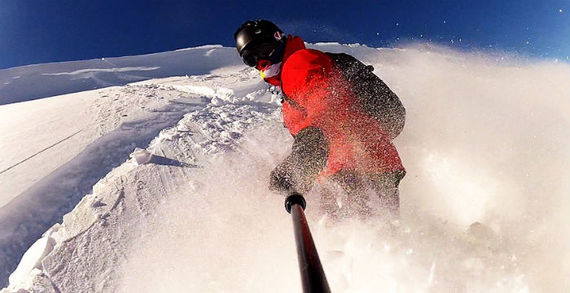
The title of this post is pretty incredulous, isn't it? How in the world can someone expect to get better at something every single time they do it? Skiing and snowboarding is so hugely complex, how can you possibly measure if you're actually getting better?
In my last post, I discussed how to learn to ski or ride at age 30 and beyond. In this post, I want to discuss the possibility of improving your skills every time you hit the slopes, regardless of current skill level. Because if you get better at the smaller components every single time, aren't you getting better overall every single time?
Change Your Vocabulary
A lot of people say they want to be good at skiing or snowboarding, but what does that mean? How do you define good for yourself? Is it huckin' 100-foot cliffs like Jeremy Jones, or is it being able to ride a black groomer from top to bottom smoothly without a fall?
In either case, good is made up of a lot of smaller components and more specific skills. If you only focus on the endpoint of becoming good, do you know how to get there? There's nothing wrong with wanting to be good at something, but instead of focusing on a highly complex goal, be more specific.
"In order to be good at tree runs, I need to be comfortable riding switch, riding in confined spaces, speed control, and super fast switch turns."
Don't just settle on being good at some huge grandiose goal -- be good at everything that goes into that goal. Instead of saying you just want to be good, say you want to be good at something.
Follow Your Intuition
I don't think writing out a schedule and forcing yourself to follow what is written down on a piece of paper is really a great way to go about getting better. Let's face it, most of us are weekend warriors or even less than that. How do you know that in 2 weeks from now, you're going to feel like practicing riding switch? How can you tell that you've gotten enough sleep and eaten the correct foods to try tackle the biggest mogul run at the resort? What if your schedule says you're going to work on smoothing out your black runs on a groomer, but instead, it's an epic powder day and you'd rather practice hucking off stuff (so that if you fall you have a nice soft landing)?
You can't.
But luckily our minds and bodies are trying to help us out.
We all have innate feelings (or sensations) and intuition. Feelings that make us say, "I feel like eating this right now." Or, "I really wish I was doing that instead." Doing or acting on these sensations will likely result in increased satisfaction and performance. If you get to go eat chicken soup when you want to eat chicken soup, there's a better chance of you really enjoying chicken soup. If your workout schedule calls for doing pull-ups, but you'd rather go crush some lunges to work on that perfect tele form, you'll probably perform better at lunges than you would at pull-ups.
This is partly because if you get to fulfill an urge, it will probably make you happy. And if you're happy, you're much more likely to learn better.
In this story from Edutopia, Co-founder of the NeuroLeadership Institute Dr. David Rock says:
"Engagement is a state of being willing to do difficult things, to take risks, to think deeply about issues and develop new solutions. ... Interest, happiness, joy, and desire are approach emotions. This state is one of increased dopamine levels, important for interest and learning."
He goes on to say:
"There is a large and growing body of research which indicates that people experiencing positive emotions perceive more options when trying to solve problems, solve more non-linear problems that require insight, [and they] collaborate better and generally perform better overall."
Likewise, in this post from SHIFT's eLearning blog, Frank Thissen, a Multimedia Didactics and Intercultural Communication professor at the University of Applied Sciences in Stuttgart, Germany says that, "First there is emotion; after that comes cognition."
While these quotes are related to classroom learning, practicing a sport is nothing more than learning the cognitive skill of your sport. It makes sense to do the things we want to do, to make ourselves happier, in order to do them better, does it not? If you're nerdy like me and need more proof, here's an article that lists actual studies on the relationship of emotional state and learning.
Focus on One Skill at a Time
Once we start following our intuition, we're free to work on whatever feels good that day. We're also free to avoid things that scare us or that we're not comfortable with. There are infinite ways to breakdown the movements that make a good skier good, so if we focus on the ones that are fun and easy on that day, or in that moment, while avoiding the ones that put us in a negative state, we can become better much faster.
I don't know about you, but some days, the thought of falling or smacking a tree at full speed just sounds absolutely terrifying. Yet other days, I don't give it a second thought. I jump, drop, and carve through the trees without even thinking about it.
By taking what I define as good for myself and breaking it down into smaller pieces, I've almost gotten to the point where I'm ready to face my biggest challenge in just a season-and-a-half. For my own goals, I want to be able to skin up a mountain and be able to handle whatever it throws at me. That's a big goal, but I've broken it down into smaller skills:
- Tree runs
- Jumps
- Speed control
- Bumps
- Drops
- Riding switch
- Carving in powder
- Adjusting to changing snow conditions with the same run
- Riding in blinding white-outs
- etc.
The possibilities are endless, but if you notice, each one of those can be broken down into smaller components.
Once we define what makes a good snowboarder good to us, we can start breaking down those components. Maybe you know exactly what you feel like doing that day before you even get to the lift. Work on that. Maybe you feel like doing one thing on the ride to the mountain, but by the time you start going down your first run, you feel like doing something else. Work on that.
Maybe you have no idea what you feel like doing or even feel like skiing at all. In this case, there are a few options depending on the frequency you can practice. If you're a ski bum and ski every day, take the day off. You're not going to lose every bit of skill you've acquired up to this point. A day of rest will probably do you good anyways. If you're a weekend warrior, you might want to try a few runs and see if your intuition tells you anything once you get warmed up. If not, maybe you just need to go eat a cookie in the chalet. And if this is your one and only ski vacation of the season, well, now is the time to say suck it up, buttercup.
If you want to become good at skiing, listen to those sensations while you're on the mountain. While you might be too scared to take a 3-foot drop on that day, maybe going slow and riding switch is fun. Maybe going super fast down the steeps seems incredibly easy. The key is to work on whatever feels easy every time you're out. Once you starting getting good at each component, every single day you ski, you'll become good all around.

